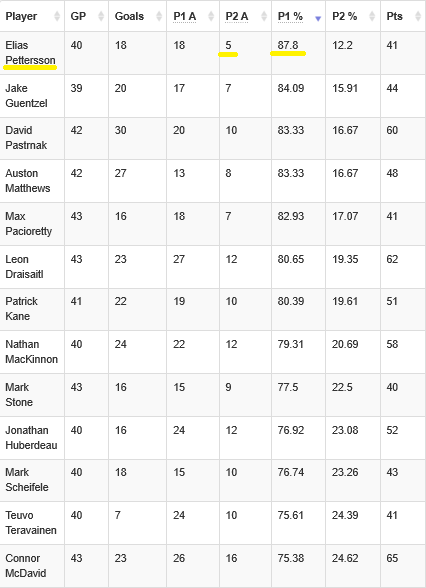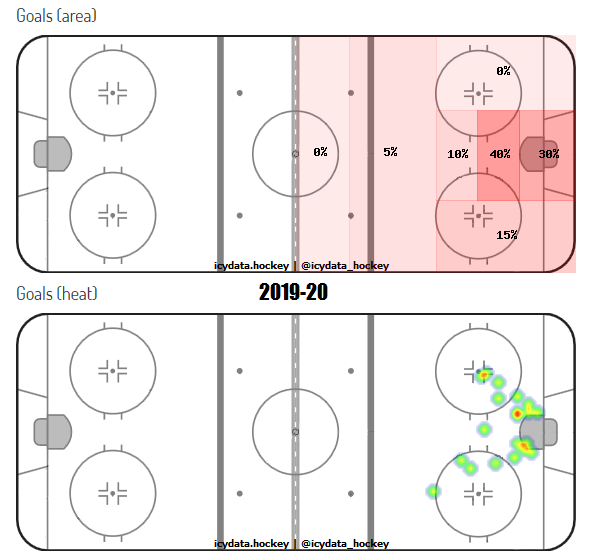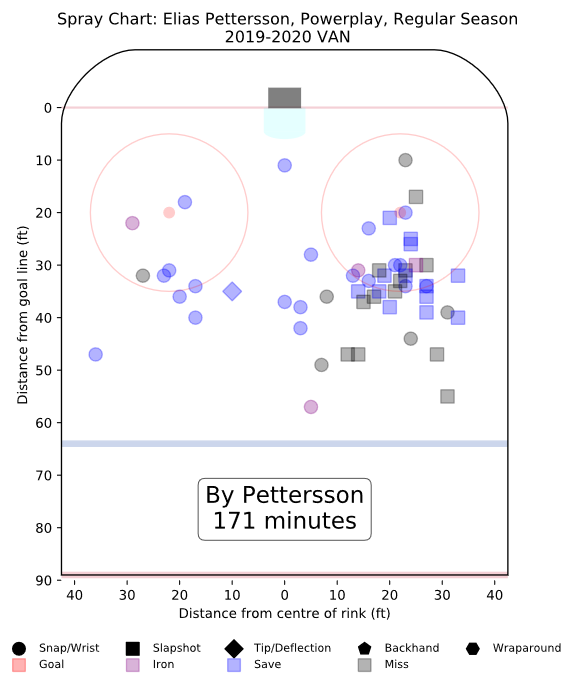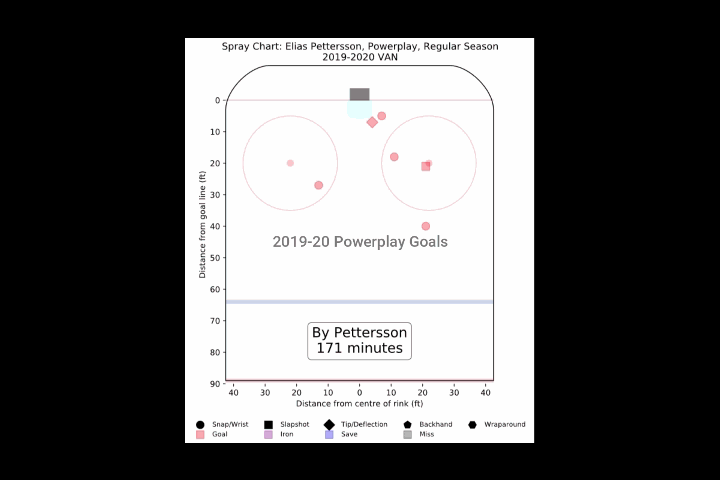Elias Pettersson’s Scoring is Evolving in his Sophomore Season

By Faber
4 years agoIf 2018-19 was the season that Elias Pettersson shocked the hockey world, then 2019-20 is the season that he is asserting his dominance. The Canucks have found their scoring leader for years to come. Elias Pettersson was just named to his second All-Star game and he will hopefully be joined by Quinn Hughes as well. (VOTE HERE.)
Pettersson’s production trailed off towards the end of his rookie year, scoring only 12 points in his final 22 games of 2018-19. Some fans speculated that opposing teams were figuring out his tendencies, or even talked about the dreaded “Sophmore Slump” that seems to be the norm for young players rather than the exception.
The thing about Elias Pettersson, however, is that he isn’t the norm. He’s exceptional.
Pettersson has eight goals in his last 13 games and is now on pace for a 36-goal, point-per-game campaign, largely due to the way he’s adapted his offensive play in his sophomore season.
Primary Point Petey
Elias Pettersson is an excellent primary point producer, which means he racks up a high number of goals and primary assists. When evaluating offensive players, it’s wise to look at primary points because they are considered more repeatable than total points.
Pettersson currently ranks fifth in the NHL among players with a minimum of 30 points in primary point percentage, with 87.8% of his point coming from a goal or a first assist. If you look at all the players that have more than 40 points this season, Elias Pettersson leads all the NHL with his primary point percentage.

Simply put, the puck runs though Petey whenever he’s on the ice. Among players with at least 25 points, Pettersson leads the entire NHL when it comes to 5-on-5 primary point percentage with an incredible 92%, which bests the totals of some of the world’s best players.
| Name | Primary Points Percentage at 5on5 (5on5 P1%) |
| Elias Pettersson | 92.00% |
| Connor McDavid | 77.14% |
| David Pastrnak | 86.11% |
| Nathan MacKinnon | 78.38% |
| Auston Matthews | 87.88% |
His primary assists have also come from goals scored by players throughout the lineup. Pettersson has gotten first assists with seven different players this season: Brock Boeser (7), Bo Horvat (4), J.T. Miller (3), Alex Edler (1), Tim Schaller (1), Tyler Motte (1) and Josh Leivo (1).
If you take a look at the top three that he assists on they come from very different parts of the ice. Horvat is a simple one, Pettersson has been setting up Horvat in tight to score on the powerplay. Horvat’s four goals come at an average of 9.5 feet away from the net. Brock Boeser’s goals from Pettersson come from all over on the ice, 8 to 26 feet away from the net. JT Miller’s goals come from a lot further away than the rest. The average distance of Miller’s three goals assisted by Pettersson is 26 feet.
Pettersson is proving that he is a versatile player that can set up offence no matter where he is stationed in the offensive zone, which is an improvement on his performance last season.
The Petterzone is Evolving
Last season, Elias Pettersson’s deadly one-timer helped him earn a reputation as one of the league’s most dangerous players on the man advantage. This season, the “Petterzone” has evolved.


Thanks to IcyData for their shot and goal charts.
Putting pucks on net is always a good thing, but the areas that those shots are coming from are also important to consider. This year, a higher portion of Pettersson’s goals are coming from high-danger areas. Pettersson has been willing to get into the dirty areas more and has been rewarded for his efforts.
The scariest part about Pettersson’s season is that he hasn’t really hit a hot streak yet. He has had runs of games with plenty of points, but I can’t be the only one who thinks that we haven’t seen him catch fire like we saw at times last season. As his confidence builds he should begin putting the puck in the net more often instead of ringing it off the bar or missing the net entirely. Hockey truly is a game of inches and as tough as it is to believe given his production, he’s looked like he’s an inch off more often than not this season.
He only has one power play goal from the “Petterzone” this season, but has hit the bar a few times and missed the net on a lot of shot attempts this season. Here are the shot attempts that either missed the net or were saved from this season.

Here’s a comparison of the powerplay goals from his two years in the NHL.

Individual Goal Chart provided by HockeyViz.
The way that Pettersson has diversified his offensive toolkit has been extremely impressive. The so-called “Petterzone” is no longer a small area. When he is up top with Quinn Hughes, he is dangerous with his one-timer. When he is rotating with JT Miller on the right side of the powerplay, he is able to setup Horvat in tight for some easy goals. Right now he is rounding out his NHL scoring ability and becoming one of the most productive players in the NHL.
Pettersson just turned 21 years old. He is being shadowed by opponent checking lines and being keyed on with the first powerplay unit. He is still getting stronger, and we have heard about his relentless work ethic in the offseason. The main thing he needs to work on now is fine-tuning his elite skill set. A few more dekes, a couple more accurate shots, and the league will be talking about Pettersson alongside the highest echelon of elite players in the NHL, if they aren’t already.
Recent articles from Faber





